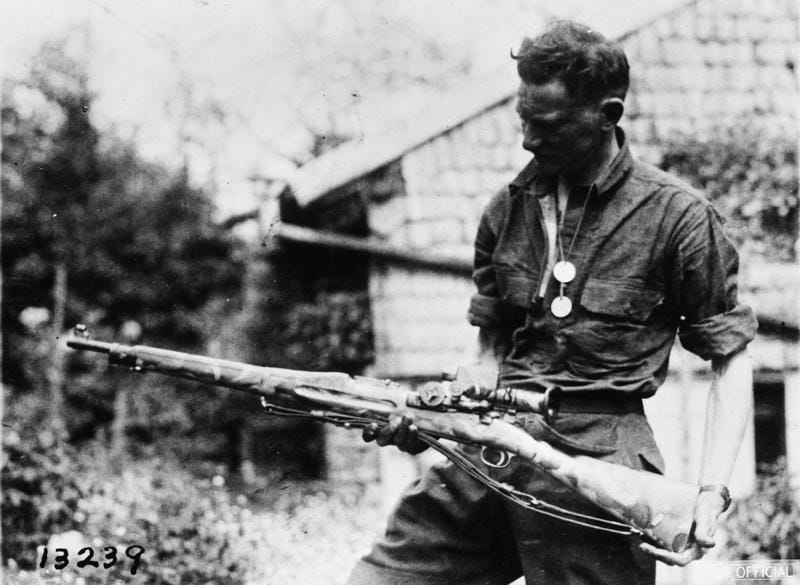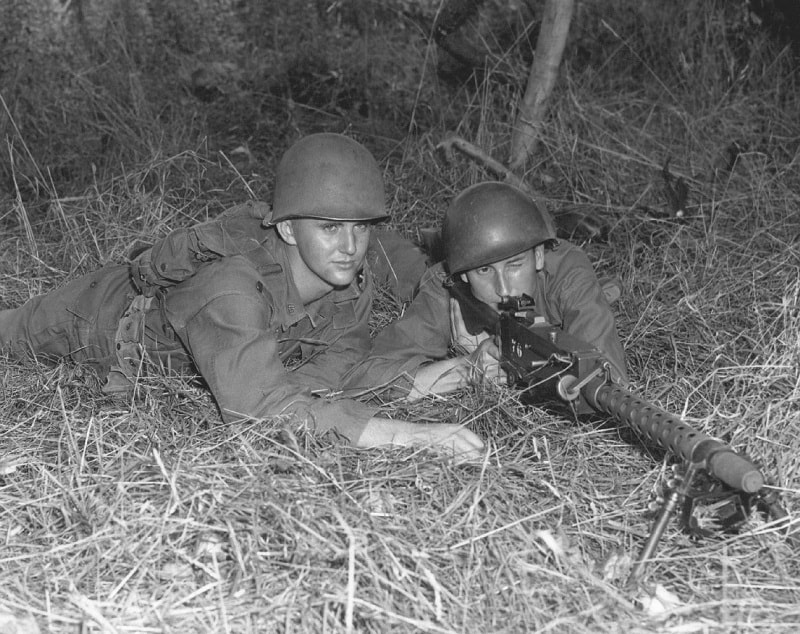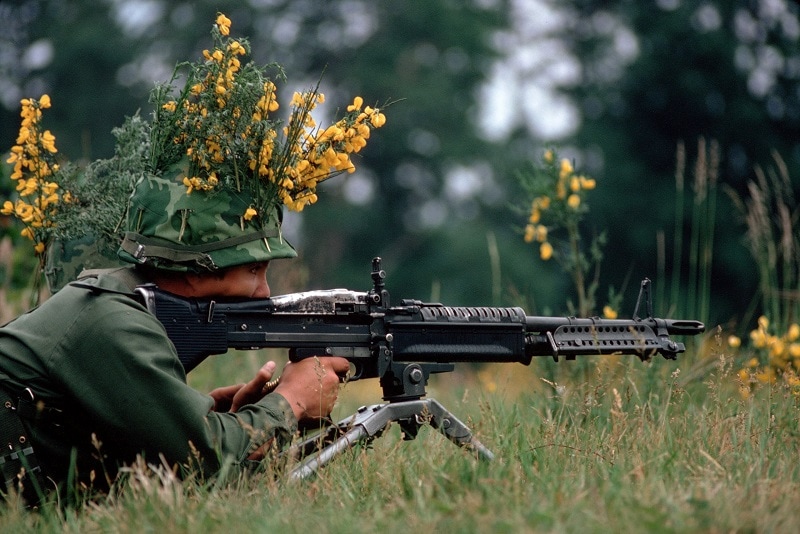Longest Continuous Fired Machine Gun Vickers Test
The United States military is currently seeking to replace its M4 Carbine and M249 squad assault weapon (SAW), while the M240 could also soon be replaced by a more modern platform. And while the M240's replacement could even fill the role employed by the M2 .50 caliber, it isn't likely the "Ma Deuce" will be retired anytime soon. Despite its nearly 90 years of service, it just does the job.
It is just one of a few weapons that remained in the American arsenal for decades. Here are what I would argue are just a sample of some of the longest serving guns in U.S. military history:
M1903 Springfield

Camouflaged M1903 Springfield sniper's rifle with Warner & Swasey telescopic sight, in France, May 1918.
Arguably the best bolt action rifle ever employed by the U.S. military, the M1903 Springfield isn't used today but it was in service for 60 years. A respectable run for any firearm.
The M1903 was developed after the Spanish-American War to replace the Springfield Model 1892–99 Krag–Jørgensen, a rifle that did the job but was clearly outclassed by the Spanish M1893 Mauser. Seeing the advantages that the Mauser offered, the American military copied the basic design and the result was the M1903 Springfield, chambered in .30-06.
It went on to be the standard infantry rifle during the First World War, and it stayed in that role until it was replaced by the M1 Garand in the late 1930s. The Springfield M1903 had a rate of fire of 10-15 rounds per minute, and it held five rounds in an internal box magazine. Its effective range was around 900 meters while its maximum range was 5,000 meters.
When the United States entered the Second World War in late 1941 production of the M1 Garand was only ramping up, so many American soldiers were still using the M1903. It was soon updated as the M1903A3, which featured improved sights, and while the rifle saw use in North Africa and notably in the Pacific, by D-Day most GIs had an M1 Garand. However, the M1903 was fitted with a scope and still used by snipers – as noted in the film Saving Private Ryan. It was employed as a sniper rifle in Korea and even the early stages of the Vietnam War.
The Colt 1911

Among the most famous of John Browning's firearm designs was the Colt M1911 .45 pistol, which was used by the U.S. military from the 1911 until 1986 when it was finally replaced by the 9mm Beretta M9 pistol.
Often known as the .45, the M1911 was a single-action, semi-automatic handgun that was magazine-fed and recoil-operated. As noted by its famous moniker, it fired the .45 ACP cartridge. Some 2.7 million M1911 and the later M1911A1 variation were produced throughout its long service with the U.S. military. World War II production actually exceeded 1.9 million units, with versions produced by several companies including Remington Rand, Colt, Ithaca Gun Company, Union Switch & Signal and even Singer. It is worth noting that so many M1911A1s were produced during World War II that the government never actually ordered new pistols, and instead relied on existing parts inventories in the years following the war.
Modernized variants of the M1911 are still used today by the U.S. Army Special Forces and U.S. Navy.
The Browning M1919 Machine Gun

U.S. (Jerry Harrison) and W. German cadets training together – firing machine gun, W. Germany, 1960.
A testament to the designs of John Browning are that in addition to the M1911 is the fact that he also developed the innovative water-cooled M1917 .30 caliber heavy machine gun, which truly improved upon the Maxim and Vickers designs that were used during the First World War.
But he didn't stop there; he then improved his own design with the M1919 Browning, an air-cooled medium machine gun. The belt-fed, recoil-operate weapon had a reasonable rate of fire, ranging from 400-600 rounds per minute and an effective range of 1,400 meters.
During World War II it was used by infantry, mounted on Jeeps, tanks, aircraft and even landing craft on D-Day. While the development of general-purpose machine guns in the Cold War relegated the M1919 to a secondary role even 100 years later this .30 caliber weapon is still very much in use today.
M2 .50 caliber

Pfc. Kathy Simmons, 56th Engineer Company (Vertical), 2nd Engineer Brigade, of St. Helena Island, S.C., engages the 10-meter target with the M2 .50 caliber machine gun at the Temporary Machinegun Range, JBER-Richardson, Tuesday, Aug. 14, 2012. Army machine gun marksmanship is based on the concept that soldiers must be able to effectively apply their firing skills in combat. Teams, consisting of a gunner and assistant gunner, underwent basic non-firing training covering maintenance and immediate action drills and an initial 10-meter live fire grouping/setting course, and weapons qualification.
The same basic design principles of the M1919 were also applied to the M2 .50 caliber machine gun. It was during the First World War that American Expeditionary Force commander Gen. John J. Pershing called up the Army Ordnance Department to develop an even larger "heavy machine gun."
Browning began to redesign his M1917 machine gun for a larger and more powerful round and that resulted in the development of the .50 inch (12.7mm) caliber firearm cartridge. A prototype weapon was tested in October 1918, but it was heavy, difficult to control, and fired too slowly for an anti-personal role. However, Browning continued to work on the weapon he developed water-cooled M1921 Browning machine gun.
Work continued after Browning died in 1926, and this led to a variant without a water jacket but with a thicker-walled, air-cooled barrel. Designed the M2 HB (Heavy Barrel), the weapon still has the heart and soul of the prolific arms designer. Introduced in 1933, it has been mounted on countless tanks, aircraft, ships and other military vehicles. As machine guns go, the M2 is an old workhorse that isn't going out to pasture anytime soon.
M60 Machine Gun

A camouflaged infantryman armed with an M60 machine gun.
Adopted in 1957 as the U.S. military's general-purpose machine gun, the M60 actually "borrowed" liberally from the German MG42 machine gun's feed system while it also used the operating system of the FG42. The result was a gas-operated, air-cooled, belt-fed 7.62mm machine gun that was technically a crew-served weapon – meaning a team of three would transport, load and fire it – but it could still be handled by a single soldier.
Meant to replace both the M1918 Browning Automatic Rifle and M1919A6 Browning machine gun, the M60 was introduced in 1957, it was perhaps the best Cold War era general-purpose machine gun. It saw use in Vietnam but has been used in nearly every major conflict around the globe since.
Peter Suciu is a Michigan-based writer who has contributed to more than four dozen magazines, newspapers and websites. He regularly writes about military small arms, and is the author of several books on military headgear including A Gallery of Military Headdress, which is available on Amazon.com.
Source: https://www.19fortyfive.com/2021/02/longest-serving-guns-in-u-s-military-history/
0 Response to "Longest Continuous Fired Machine Gun Vickers Test"
Postar um comentário